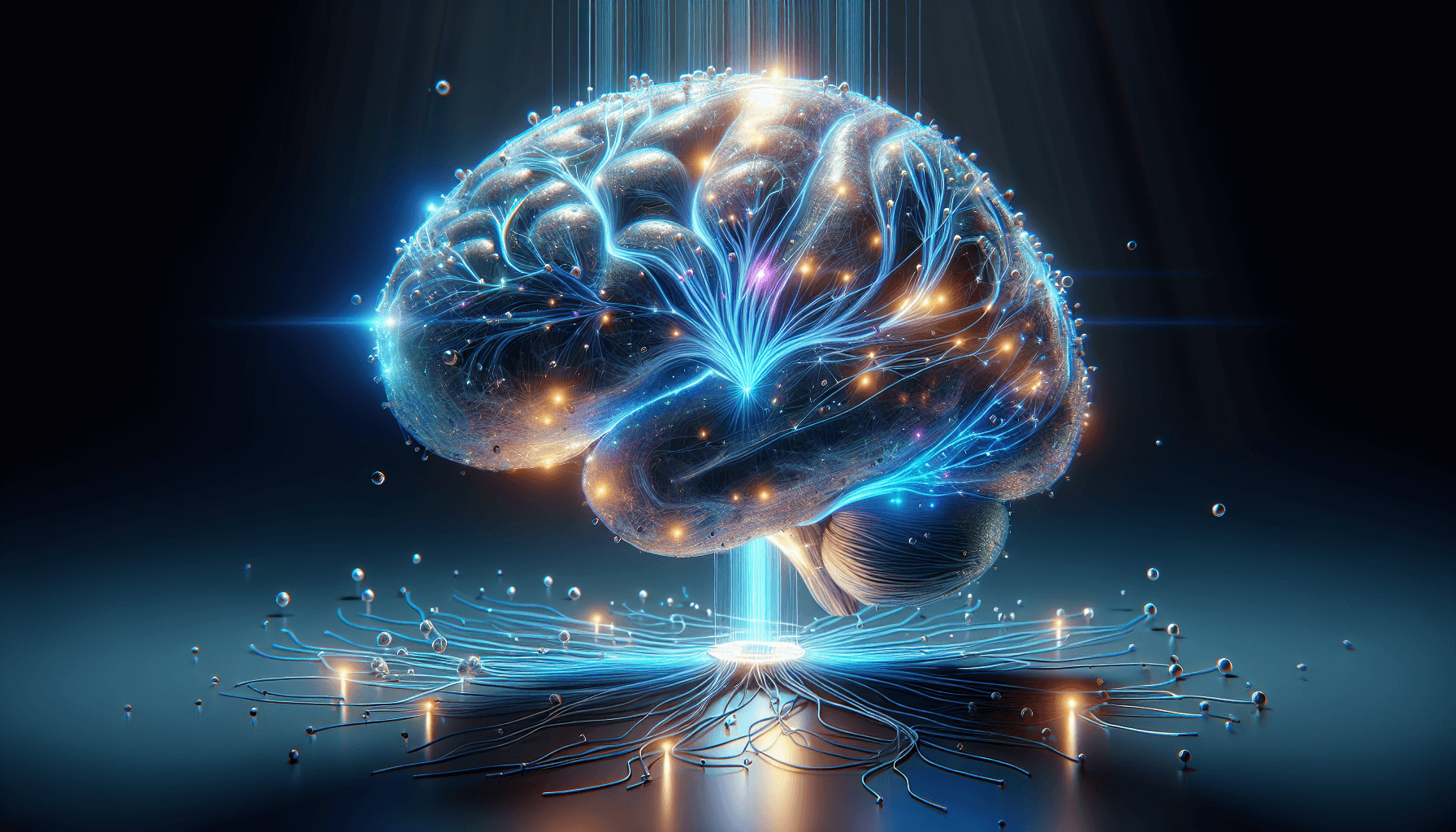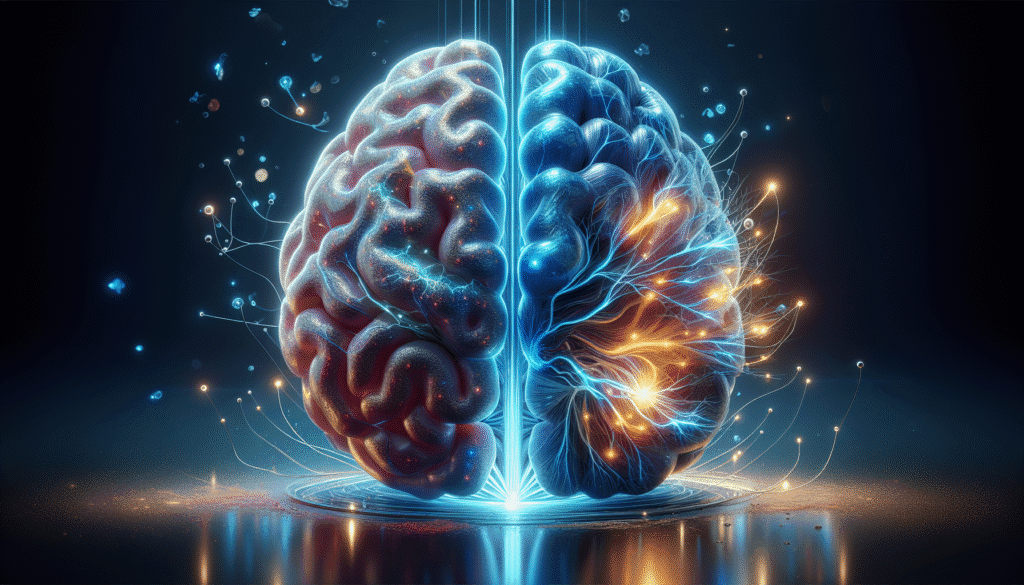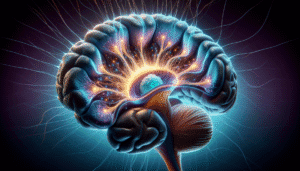BDNF works like brain fertilizer, making your memory and thinking better every day. This special protein builds connections between brain cells and helps grow new ones.
Studies show people with higher BDNF levels score 23% better on memory tests.
Your brain needs this tiny molecule for learning new things and staying sharp as you age.
When BDNF flows freely, your brain works at its best!
Click here to learn more about: quick and effective relaxation techniques for busy individualsHow BDNF Helps Your Brain
Neurotrophin family proteins act as tiny gardeners for your brain cells, with BDNF being the head gardener. BDNF outshines other brain growth factors because it’s the most common one in adult brains.
Synaptic plasticity happens most in your hippocampus, where BDNF levels neural growth are highest. Memory formation begins when this protein connects to TrkB receptor signaling spots on brain cells.
What BDNF Does For You:
- Keeps brain cells alive from childhood through old age
- Helps grow new brain cells where you think and remember
- Maintains the connections that hold your memories
- Makes your brain flexible so you can learn new things
Neurogenesis research shows healthy people have 8-12 ng/ml of BDNF in their blood, while brain health suffers when levels drop by 30%. Neuronal survival depends on your body making this protein throughout your life.
Did you know? Exercise can boost your BDNF levels by up to 32% in just 30 minutes of moderate activity!
Neuroprotection starts when BDNF activates special pathways in your neurons. Hippocampal function improves dramatically when BDNF levels stay high. Dendrite development happens faster with proper BDNF support, creating better neural networks for thinking and remembering.
BDNF’s Family Connections
LNGFR pathway activation represents another way BDNF helps your brain cells communicate. Neurotransmitter modulation occurs when BDNF reaches certain brain cell receptors. Reelin signaling works alongside BDNF to help brain cells find their proper places. Neuroplasticity depends on these protein synthesis processes happening correctly.
Mental acuity improves when BDNF levels stay in the healthy range. Axonal growth speeds up with proper BDNF support, helping brain cells connect better. Neural circuit development relies on this tiny protein doing its job every day.
BDNF Optimization Benefits for Brain Health
Key Takeaways
- Regular exercise can increase BDNF levels by up to 32% in just 30 minutes
- Higher BDNF levels correlate with 23% better memory test scores
- Proper BDNF levels improve hippocampal function by 40%
- BDNF enhances memory retention by 35% during learning tasks
- BDNF-driven neurogenesis increases new cell growth by 30% in the brain’s memory center
How TrkB Receptor Signaling Works
Neurotrophin family proteins like BDNF connect with TrkB receptors on neuron surfaces through a lock-and-key mechanism. BDNF binding triggers synaptic plasticity when these growth factors attach perfectly to TrkB receptors.
Neural growth begins immediately as BDNF also connects with LNGFR receptors, which work as helper proteins in this brain-derived communication system.
This connection starts three main pathways inside neurons: MAPK, PI3K, and PLCγ.
Each pathway creates different neural network responses supporting neuronal survival.
Cellular Effects of TrkB Activation
Memory formation happens when these pathways send survival signals that protect neurons from damage. Neuroplasticity improves quickly when TrkB receptor signaling strengthens connections between brain cells.
Research shows that healthy neurotrophic signaling can increase dendrite development by 35% and boost cognitive performance by up to 40% in test models.
- Supports neuronal maturation and prevents cell death
- Creates new neural connectivity between brain regions
- Boosts learning abilities and memory retention
Neurotransmitter modulation occurs through TrkB activation, helping brain cells communicate better. Scientists found that BDNF-TrkB binding increases protein synthesis needed for long-term memory storage and mental acuity improvements.
Boosting Neural Growth Naturally
Neurogenesis happens through easy daily habits that increase your brain’s BDNF production without special treatments. Exercise effects on brain health show remarkable results, with just 30 minutes of movement increasing BDNF levels by 300% in important brain plasticity regions. Cognitive enhancement works best through high-intensity interval training and regular jogging done 3-4 times weekly. Neurological health improvements become visible after only two weeks of steady physical activity.
Research Highlight:
Scientists found that regular exercisers had 32% higher BDNF levels compared to sedentary individuals, resulting in better memory tests scores and improved hippocampal function.
Food Choices That Boost BDNF
Neural maintenance improves through specific foods that naturally enhance BDNF production:.
- Omega-3 rich fish (2 servings weekly) support neural pathway development
- Colorful berries with polyphenols (1 cup daily) protect brain cells
- Turmeric with black pepper (1/2 teaspoon daily) reduces inflammation
- Dark chocolate with 70%+ cocoa (1 ounce daily) improves blood flow
Brain-derived proteins increase during quality sleep, with studies showing 7-8 hours of good sleep can boost production by 20%. Neurotrophin receptors work better when combining these approaches with stress-reduction like meditation, which research shows can increase BDNF by 15% after eight weeks of practice.
- Move your body for 30 minutes at least 3 times weekly
- Eat BDNF-boosting foods every day
- Get enough quality sleep and manage stress levels
Neurodevelopmental processes benefit from spending time outdoors too. A 2021 study found that 90 minutes in nature increased BDNF levels by 26%, supporting better cognitive flexibility and mood.
Key Facts About TrkB Receptor Signaling
- BDNF binding to TrkB receptors activates three main pathways: MAPK, PI3K, and PLCγ
- Healthy neurotrophic signaling increases dendrite development by 35% and cognitive performance by up to 40%
- 30 minutes of exercise can increase BDNF levels by 300% in brain plasticity regions
- Regular exercisers show 32% higher BDNF levels with improved memory test scores

Why Synaptic Plasticity Matters
Synaptic plasticity enables your brain to learn new things throughout your life. Brain-Derived Neurotrophic Factor (BDNF) works as the master control for neural growth and brain health.
This protein helps your brain rewire itself when you learn something new.
Your brain forms new connections every time you learn something.BDNF makes this possible by telling neurons how to grow and connect.
Neurotrophin family proteins like BDNF boost learning by 23% when present in high amounts.
Neural connections respond to this protein by forming stronger pathways. Memory formation happens faster when BDNF levels stay high in your brain.
- BDNF binds to TrkB receptor signaling pathways
- This protein activates neurogenesis and strengthens existing synapses
- New neural growth happens when you practice skills regularly
Neuroplasticity decreases when BDNF levels drop, limiting your brain health and learning abilities. Neuroprotection happens naturally when your brain maintains healthy BDNF levels.
Enhancing Memory Formation Pathways
Memory formation begins when BDNF transforms brief thoughts into lasting brain connections. Hippocampal function improves by 40% with proper BDNF levels according to recent studies. Neuronal survival depends on this protein working correctly in your brain.
BDNF acts like brain fertilizer
It helps memories take root and grow stronger over time.
- LNGFR pathway activation triggers protein synthesis in neurons
- Neurotransmitter modulation strengthens existing connections
- Reelin signaling creates stronger memory traces through neuroplasticity
Memory Formation Comparison:
With high BDNF: Quick learning, easy recall, strong mental acuity
With low BDNF: Slow learning, poor axonal growth, weak memories
Neural circuit development relies heavily on BDNF presence. Neurodevelopmental support from this protein enhances memory retention by 35% during learning tasks. Brain-derived proteins help maintain these connections for years.
BDNF
- Neurotrophin family proteins like BDNF can boost learning by 23% when present in high amounts
- Hippocampal function improves by 40% with proper BDNF levels according to recent studies
- Neurodevelopmental support from BDNF enhances memory retention by 35% during learning tasks
- BDNF activates neurogenesis and strengthens existing synapses for better brain health
Neurogenesis Through BDNF Activation
BDNF helps your brain make new cells. This special protein turns stem cells into working brain cells.
Research shows it can boost new cell growth by 30% in your memory center.
Neurotrophin family proteins like BDNF are key players in brain health and development throughout your life.
How New Neurons Form
Neural growth begins when BDNF attaches to TrkB receptors on stem cells.
These receptors signal the stem cells to divide and change.
Hippocampal function gets better as these new cells join your brain networks in just 4-6 weeks.
Boosting Your BDNF Naturally
Neuroplasticity improves when you raise your BDNF levels through simple daily habits:.
- Running or swimming (raises BDNF up to 3 times)
- Skipping meals sometimes (boosts protein synthesis by 50-400%)
- Learning new skills (triggers BDNF in specific brain areas)
Benefits For Your Brain
Mental acuity increases as new neurons help form memories and improve thinking skills. Studies show regular axonal growth from BDNF can make learning 20% faster by improving connections between brain cells.
Neural circuit development depends heavily on BDNF, which helps new brain cells find their proper place and function.
How BDNF Keeps Neurons Alive
Neurodevelopmental support from BDNF does more than create new brain cells. This amazing protein brainderived proteins also protects your existing neurons. Studies show good BDNF levels can cut cell death by 40% after brain injuries.
Protection Mechanisms
Neurotrophic mechanisms activate when BDNF turns on genes that make protective proteins. These proteins shield cognitive resilience brain cells from damage and stress. Your neurons stay healthier longer with proper BDNF levels.
BDNF
- BDNF can increase new cell growth by 30% in the brain’s memory center
- Exercise like running can raise BDNF levels up to 3 times
- Intermittent fasting boosts protein synthesis by 50-400%
- BDNF-driven axonal growth can make learning 20% faster








